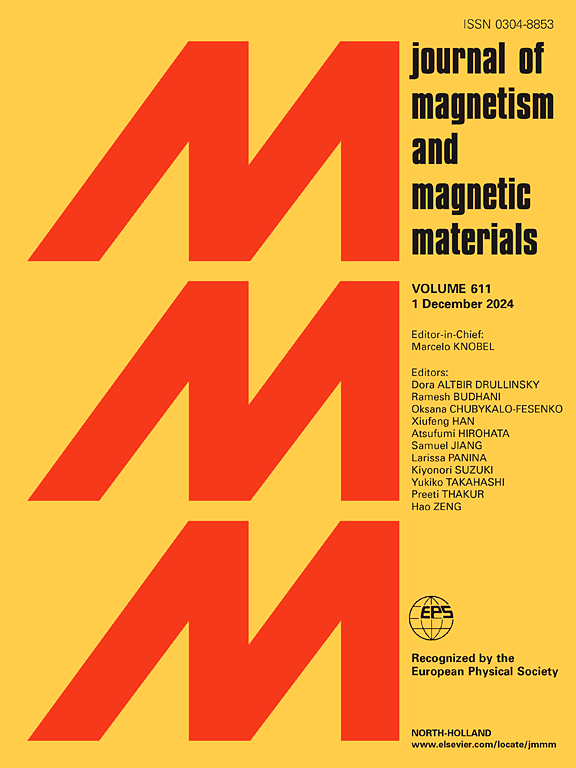MPX3 (M = Mn, Ni)应变控制磁性能的第一性原理研究X = S, Se)单层
IF 2.5
3区 材料科学
Q3 MATERIALS SCIENCE, MULTIDISCIPLINARY
引用次数: 0
摘要
二维材料MPX3 (M = 3d过渡金属;X =硫原)单层膜由于其丰富的磁相图和各种应用潜力而引起了人们的极大关注。不同磁交换相互作用之间的复杂竞争使得NiPX3 (X = S, Se)单层膜处于锯齿反铁磁(AFM)相和nsamel -AFM相之间的关键区域,这意味着它们的磁性能可以被多个磁场调制。在这项研究中,我们采用第一性原理计算系统地研究了NiPX3单层的磁性,探索了内部(元素取代)和外部应变(双轴/单轴应变)下磁性行为的调制。我们的结果表明,磁各向异性和磁光Schäfer-Hubert (SH)效应都受到应变的强烈影响。应变可引起磁易轴由面内向面外翻转,显著增强磁光SH效应。例如,在- 6%的双轴压缩应变下,NiPSe3单层的SH旋转角峰值从NiPS3的- 0.62°增加到- 1.71°。三角反棱镜晶体场的畸变和三重旋转对称的破坏是导致磁各向异性应变调谐和磁光SH效应的关键物理机制。我们的工作为实现超薄自旋电子器件的多参数功能调制提供了理论框架和材料设计方法。本文章由计算机程序翻译,如有差异,请以英文原文为准。
First-principles study of strain-controlled magnetic properties in MPX3 (M = Mn, Ni; X = S, Se) monolayers
Two-dimensional materials MPX3 (M = 3d transition metals; X = chalcogens) monolayers have attracted significant attention due to their rich magnetic phase diagrams and potential for various applications. The complex competition among different magnetic exchange interactions places NiPX3 (X = S, Se) monolayers at a critical region between the zigzag-antiferromagnetic (AFM) and Néel-AFM phases, implying that their magnetic properties can be modulated by multiple fields. In this study, we systematically investigated the magnetic properties of NiPX3 monolayers by employing first-principles calculations, exploring the modulation of magnetic behaviour under internal (element substitution) and external strains (biaxial/uniaxial strain). Our results demonstrate that both magnetic anisotropy and the magneto-optical Schäfer-Hubert (SH) effect are strongly influenced by strain. Specifically, strain can induce a flip of the magnetic easy axis from in-plane to out-of-plane and significantly enhance the magneto-optical SH effect. For instance, under −6 % biaxial compressive strain, the SH rotation angle peak of the NiPSe3 monolayer increases from −0.62° in NiPS3 to −1.71°. The distortion of the trigonal anti-prismatic crystal field and the breaking of the three-fold rotational symmetry are identified as the key physical mechanisms responsible for the strain-induced tuning of magnetic anisotropy and the magneto-optical SH effect. Our work provides a theoretical framework and a material design approach for achieving multi-parameter functional modulation in ultrathin spintronic devices.
求助全文
通过发布文献求助,成功后即可免费获取论文全文。
去求助
来源期刊

Journal of Magnetism and Magnetic Materials
物理-材料科学:综合
CiteScore
5.30
自引率
11.10%
发文量
1149
审稿时长
59 days
期刊介绍:
The Journal of Magnetism and Magnetic Materials provides an important forum for the disclosure and discussion of original contributions covering the whole spectrum of topics, from basic magnetism to the technology and applications of magnetic materials. The journal encourages greater interaction between the basic and applied sub-disciplines of magnetism with comprehensive review articles, in addition to full-length contributions. In addition, other categories of contributions are welcome, including Critical Focused issues, Current Perspectives and Outreach to the General Public.
Main Categories:
Full-length articles:
Technically original research documents that report results of value to the communities that comprise the journal audience. The link between chemical, structural and microstructural properties on the one hand and magnetic properties on the other hand are encouraged.
In addition to general topics covering all areas of magnetism and magnetic materials, the full-length articles also include three sub-sections, focusing on Nanomagnetism, Spintronics and Applications.
The sub-section on Nanomagnetism contains articles on magnetic nanoparticles, nanowires, thin films, 2D materials and other nanoscale magnetic materials and their applications.
The sub-section on Spintronics contains articles on magnetoresistance, magnetoimpedance, magneto-optical phenomena, Micro-Electro-Mechanical Systems (MEMS), and other topics related to spin current control and magneto-transport phenomena. The sub-section on Applications display papers that focus on applications of magnetic materials. The applications need to show a connection to magnetism.
Review articles:
Review articles organize, clarify, and summarize existing major works in the areas covered by the Journal and provide comprehensive citations to the full spectrum of relevant literature.
 求助内容:
求助内容: 应助结果提醒方式:
应助结果提醒方式:


